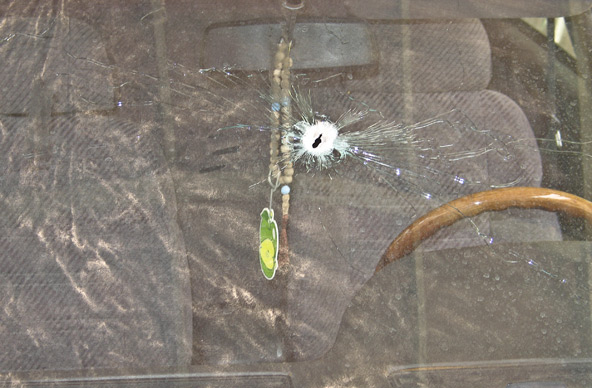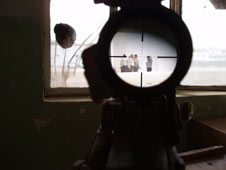
Iraq, June 2005. The single bullet that killed Yassir Salihee passed through the windshield of his car, directly into his brain. Joe Romero fired the bullet after firing at the car first.
Photo: Sergeant Joe Romero
The sniper lowered his voice when he talked about the pictures of the car and the man inside it. His self-assured manner disappeared and he became nervous. "Here is one of ours. I really hope he was a bad guy. Do you know anything about him?" Then he said, "See, I don't know if I should be talking about this."
"Did you fire the shot that killed him?" I asked.
"I don't know."
Joe said that it was true that he fired the shot through the Espero's windshield, but he wasn't positive if it was the lethal shot. There was no doubt that it was, but Joe seemed to be genuinely uncertain about it. It was clear that he did not want it to be true.
The next day, I asked Joe if I could interview him about what happened that day. He agreed, but asked me not to use his full name because he was afraid of retribution in the United States. "I don't want someone coming after me," he said. I did not reveal that I'd been looking for him for two weeks.
The day after I looked at the photos on Joe's laptop, I went out with his platoon on a patrol in Amariyah. It was July 14 and it was 125 degrees. Within a few minutes we were drenched with sweat. "This is a perfect place for a vee-bid," the platoon sergeant said as he stood outside the concertina wire on a busy street. (For security reasons, none of the soldiers involved will be named.) He was halfway through handing out a thousand frozen chickens in a part of the city that has been flooded by refugees from Fallujah and Ramadi. It was not a good place to stand on the street for longer than a few minutes and no one wanted to be there. "Vee-bid" is U.S. slang for a Vehicle Borne Improvised Explosive Device, a weapon otherwise known as a car bomb, which insurgents prefer to use against U.S. forces because there is no defense against it. The armor on Humvees will not stop the force of a blast fueled by artillery shells and anti-tank mines. Whenever soldiers talk about vee-bids, their sense of dread comes through.
The soldiers were not enthusiastic about giving the chickens away. One man called it "Operation Chicken Choker" because he didn't want to be blown up giving food to people who were sympathetic to the insurgents. It was easy to see what he was talking about. Amariyah, which is mostly a Sunni neighborhood, was home to high-level military officers for the previous regime, and many of them have fled to Jordan and Syria where they provide funds for the insurgency. There is a constant sputter of gunfire in Amariyah. If it's not coming right down on the soldiers, they barely look up.
The platoon managed to finish the mission in 45 minutes, throwing the chickens in careful arcs to the sergeant, who relayed them gracefully to the surprised passengers of passing cars. The platoon had been waiting for the chickens for hours because they had been stuck on the highway behind a roadside bomb, and when they were finally gone, there was a sense of relief. Knowing the intensity of violence in Amariyah, sending soldiers to deliver frozen chickens in the insurgent-controlled neighborhood seemed insane.
In the evening, I went back to the company headquarters to look for Joe, who was working the night shift again. We had trouble finding a good place for the interview because people kept coming through the trailer. We eventually ended up in the first sergeant's office and closed the door. After a few minutes, I told Joe that I did know Salihee, that he was a friend, and that I wanted to hear his side of what happened. I asked him to go over the events of that day.
His answers didn't come out in a linear chronology. Instead, Joe went back and forth over the same stretch of time, describing the block where the killing happened, trying to explain what it was like to drive down that street. The American names for the crossroads where Salihee died, Screaming Lady and Cedars, came up many times when he talked about attacks on the soldiers. "We've had a lot of problems right there from Cedars at the intersection with Screaming Lady -- that is the worst part of our sector is right there," Joe said. It is a place where soldiers from Joe's company regularly come under small-arms fire and sniper attacks. The day before Salihee was killed, an insurgent sniper had shot and critically wounded a soldier in Joe's platoon named Root, less than 300 feet from the intersection. On the 24th of June, Joe and his spotter were sent out with the platoon as a counter-sniper team.
Not long after the patrol entered the area, someone spotted a man on the roof of the four-story building at the corner of Amel Al Shabi, and the platoon moved in immediately for a search, while Joe and the spotter stayed down on the street to provide security. Joe also said that the platoon was taking small-arms fire in the neighborhood and that they had to move from cover to cover to reach their final position at the intersection. This is when two cars approached the U.S. snipers, with Salihee behind the wheel of the second. I asked him to describe the moment he started firing at Salihee's car.
"I was shooting to disable when he swerved around the other car. He was going more than 20 miles an hour. We aren't used to seeing someone drive that fast." I wanted to know if Salihee had time to react, if he had time to stop. The car turning around in front of Salihee could have obscured his vision of the American patrol ahead. Joe said, "He had to have seen us, he had to have. I was standing in the middle of the road. I made eye contact with him after the warning shots. I thought, Oh my God it's a vee-bid, we're done." Joe said he was firing from a standing position and that he had moved out into the street to stop Salihee. "I fired the first warning shot at 150 meters and the last shot at 20 or 30 meters. His hands never went up. It looked like he was ducking behind the steering wheel at 70 or 80 meters. It looked like there was a small silhouette of his head." Joe said that Salihee didn't respond to the warning shots, that he didn't slow down.
The Editor and Publisher called the Victim and the Killer one of the most remarkable stories to come out of Iraq.
 LEAD IMAGE: Iraq, 2005. Joe Romero looks through the sight of his sniper rifle at a group of men.
LEAD IMAGE: Iraq, 2005. Joe Romero looks through the sight of his sniper rifle at a group of men.Photo: Sergeant Joe Romero
© Phillip Robertson, 2009-2014.
